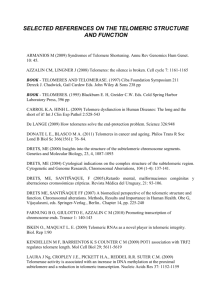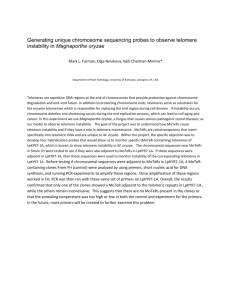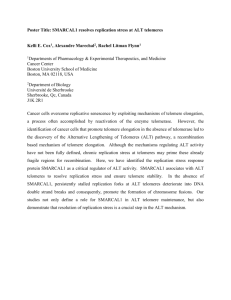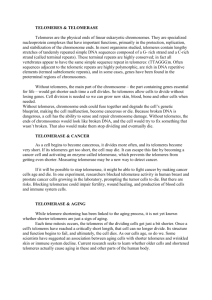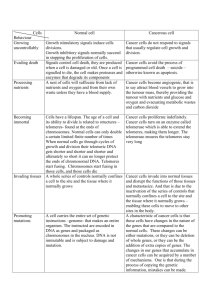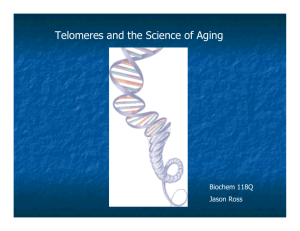telomeres and telomerase group
advertisement
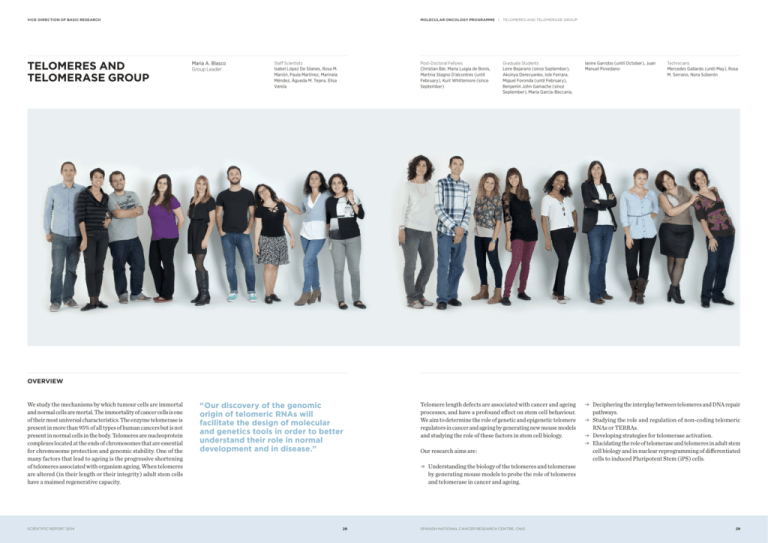
Vice-Direction of Basic Research TELOMERES AND TELOMERASE GROUP Molecular Oncology Programme | Telomeres and Telomerase Group Maria A. Blasco Group Leader Staff Scientists Isabel López De Silanes, Rosa M. Marión, Paula Martínez, Marinela Méndez, Águeda M. Tejera, Elisa Varela Post-Doctoral Fellows Christian Bär, Maria Luigia de Bonis, Martina Stagno D’alcontres ( until February ), Kurt Whittemore ( since September ) Graduate Students Leire Bejarano ( since September ), Aksinya Derevyanko, Iole Ferrara, Miguel Foronda ( until February ), Benjamin John Gamache ( since September ), María García-Beccaria, Ianire Garrobo ( until October ), Juan Manuel Povedano Technicians Mercedes Gallardo ( until May ), Rosa M. Serrano, Nora Soberón OVERVIEW We study the mechanisms by which tumour cells are immortal and normal cells are mortal. The immortality of cancer cells is one of their most universal characteristics. The enzyme telomerase is present in more than 95% of all types of human cancers but is not present in normal cells in the body. Telomeres are nucleoprotein complexes located at the ends of chromosomes that are essential for chromosome protection and genomic stability. One of the many factors that lead to ageing is the progressive shortening of telomeres associated with organism ageing. When telomeres are altered ( in their length or their integrity ) adult stem cells have a maimed regenerative capacity. SCIENTIFIC REPORT 2014 “ Our discovery of the genomic origin of telomeric RNAs will facilitate the design of molecular and genetics tools in order to better understand their role in normal development and in disease.” Telomere length defects are associated with cancer and ageing processes, and have a profound effect on stem cell behaviour. We aim to determine the role of genetic and epigenetic telomere regulators in cancer and ageing by generating new mouse models and studying the role of these factors in stem cell biology. Our research aims are : ɗɗ Understanding the biology of the telomeres and telomerase by generating mouse models to probe the role of telomeres and telomerase in cancer and ageing. 28 SPANISH NATIONAL CANCER RESEARCH CENTRE, CNIO ɗɗ Deciphering the interplay between telomeres and DNA repair pathways. ɗɗ Studying the role and regulation of non-coding telomeric RNAs or TERRAs. ɗɗ Developing strategies for telomerase activation. ɗɗ Elucidating the role of telomerase and telomeres in adult stem cell biology and in nuclear reprogramming of differentiated cells to induced Pluripotent Stem ( iPS ) cells. 29 Vice-Direction of Basic Research Molecular Oncology Programme | Telomeres and Telomerase Group RESEARCH HIGHLIGHTS Identification of the genomic origin of telomeric RNAs A gene that links stem cells, ageing and cancer Telomeric RNAs ( TERRAs ) are UUAGGG repeat-containing RNAs that rise from the transcription of the telomeric C-strand by RNA polymerase II. TERRAs are thought to be transcribed from the subtelomere towards the telomere. The precise genomic origin of TERRA has remained elusive. Using a whole-genome RNA-sequencing approach, we identified novel mouse transcripts arising mainly from the subtelomere of chromosome 18, and to a lesser extent chromosome 9, which resemble TERRA in several key aspects. Chromosome 18 transcripts contain UUAGGGrepeats, are found at telomeres with the same frequency as TERRA transcripts, are heterogeneous in size, fluctuate in abundance in a TERRA-like manner during the cell cycle, are bound by the same TERRA RNA-binding proteins that bind TERRA, are regulated by stresses in a manner similar to TERRA, and are induced upon induction of pluripotency like TERRA. These transcripts can bind to chromosome 18 telomeres as well as to the other chromosome ends ( FIGURE 1 ), although not all at once. We showed that downregulation of the transcripts that originate from chromosome 18 causes a reduction in TERRA abundance. Interestingly, downregulation of either chromosome 18 transcripts or TERRA resulted in similar induction of telomere dysfunction-induced foci, suggesting a protective role at the telomeres. Sox4 is a transcription factor whose expression in mammals is restricted to embryonic structures and some adult tissues, such as the lymphoid organs, pancreas, intestines, and skin. During embryogenesis, Sox4 regulates mesenchymal and neural progenitor survival, as well as lymphocyte and myeloid differentiation, and contributes to pancreas, bone, and heart development. Aberrant Sox4 expression in adult tissues is linked to malignant transformation and metastasis in several types of cancer in mice and humans. We have addressed the roles of Sox4 in adult tissue homeostasis and cancer. We first generated a mouse model with reduced whole-body Sox4 expression. These mice display accelerated ageing and are cancer resistant. To specifically address a role for Sox4 in adult stem cells ( FIGURE 2 ), we conditionally deleted Sox4 ( Sox4cKO ) in stratified epithelia. Sox4cKO mice showed increased skin stem cell quiescence and strong resistance to tumour development when subjected to a chemically induced carcinogenesis skin protocol ; this concomitantly with downregulation of cell cycle, DNA repair, and activated hair follicle stem cell pathways. Our findings shed light on some crucial functions of the Sox4 protein in cancer and ageing and provide new tools for elucidating Sox4 function in adult tissue homeostasis. Short telomeres are risk factors for age-associated diseases, including heart disease. We addressed the potential of telomerase ( Tert ) activation in the prevention of heart failure after myocardial infarction ( MI ) in adult mice. We used adeno-associated viruses for cardiac-specific Tert expression. We found that upon MI, hearts expressing Tert showed an improvement in cardiac functional and morphological parameters, concomitant with reduced mortality by heart failure after MI. Tert re-activation also resulted in elongated telomeres and a gene expression switch towards a regeneration signature of neonatal mice. Our work suggests that telomerase activation could be a therapeutic strategy to prevent heart failure after MI. s The SIRT1 protein has been suggested to play a role in pluripotency. In mice, SIRT1 attenuates telomere attrition in vivo and it is recruited at telomeres in induced pluripotent stem cells ( iPSCs ). Being telomere elongation an iPSC hallmark, we studied the role of SIRT1 in pluripotency in the setting of mouse embryonic fibroblasts reprogramming into iPSCs. We found that SIRT1 is required for efficient post-reprogramming telomere elongation, and that SIRT1-deficient iPSCs accumulate chromosomal aberrations and form larger teratomas that are poorly differentiated. Our work demonstrated a role for SIRT1 in regulating genomic integrity and telomere expansion. ∞∞ ∞∞ PUBLICATIONS Mouraret N, Houssaini A, Abid S, Quarck R, Marcos E, Parpaleix A, Gary-Bobo G, Dubois-Rande J, Derumeaux G, Boczkowski J, Delcroix M, Blasco MA, Lipskaia LL, Amsellem V, Adnot S. Role for Telomerase in Pulmonary Hypertension. Circulation. PMID : 25550449. Bär C, de Jesus BB, Serrano R, Tejera A, Ayuso E, Jimenez V, Formentini I, Boba- SCIENTIFIC REPORT 2014 ∞∞ dilla M, Mizrahi J, de Martino A, Gomez G, Pisano D, Mulero F, Wollert KC, Bosch F, Blasco MA. ( 2014 ). Telomerase expression confers cardioprotection in the adult mouse heart after acute myocardial infarction. Nat Commun 5, 5863. Cammas A, Sanchez BJ, Lian XJ, Dormoy-Raclet V, van der Giessen K, de Silanes IL, Ma J, Wilusz C, Richardson J, Gorospe M, Millevoi S, Giovarelli M, Gherzi R, Di Marco S, Gallouzi IE ( 2014 ). Destabi- Figure 2 Sox4 protein maintains tissue homeostasis in stem cells. Stem cells from adult mouse epidermis ( green, cytokeratin 6 ; blue, cell nucleus ). Telomerase expression confers cardioprotection Integrity of induced pluripotent stem cells ∞∞ Figure 1 Identification of the chromosomes bound by chromosome 18-TERRAs. RNA-FISH targeting both chromosome 18-RNAs and TERRA’s telomeric track : ( top-left ) RNA-FISH staining in metaphases, ( top-right ) SKY hybridisation and ( bottom ) chromosome identification by SKY. Scale bar, 10 μm. ∞∞ ∞∞ lization of nucleophosmin mRNA by the HuR/KSRP complex is required for muscle fibre formation. Nat Commun 5, 4190. De Silanes IL, Graña O, De Bonis ML, Dominguez O, Pisano DG, Blasco MA ( 2014 ). Identification of TERRA locus unveils a telomere protection role through association to nearly all chromosomes. Nat Commun 5, 4723. Foronda M, Martínez P, Schoeftner S, Gómez-López G, Schneider R, Flores JM, ∞∞ ∞∞ Pisano DG, Blasco MA ( 2014 ). Sox4 links tumor suppression to accelerated aging in mice by modulating stem cell activation. Cell Rep 8, 487-500. Martínez P, Ferrara-Romeo I, Flores JM, Blasco MA ( 2014 ). Essential role for the TRF2 telomere protein in adult skin homeostasis. Aging Cell 13, 656-668. García-Beccaria M, Martínez P, Flores JM, Blasco MA ( 2014 ). In vivo role of checkpoint kinase 2 in signaling telomere dys- 30 ∞∞ ∞∞ function. Aging Cell 13, 810-816. d’Alcontres MS, Palacios JA, Mejias D, Blasco MA ( 2014 ). TopoIIα prevents telomere fragility and formation of ultra thin DNA bridges during mitosis through TRF1-dependent binding to telomeres. Cell Cycle 13, 1463-1481. Garrobo I, Marión RM, Domínguez O, Pisano DG, Blasco MA ( 2014 ). Genome-wide analysis of in vivo TRF1 binding to chromatin restricts its location exclusively to telomeric repeats. Cell Cycle 13, 3742-3749. ∞∞ ∞∞ Benitez-Buelga C, Sanchez-Barroso L, Gallardo M, Apellániz-Ruiz M, Inglada-Pérez L, Yanowski K, Carrillo J, Garcia-Estevez L, Calvo I, Perona R, Urioste M, Osorio A, Blasco MA, Rodriguez-Antona C, Benitez J. Impact of chemotherapy on telomere length in sporadic and familial breast cancer patients. Breast Cancer Res Treat. PMID : 25528024. De Bonis ML, Ortega S, Blasco MA ( 2014 ). SIRT1 Is Necessary for Proficient Telomere SPANISH NATIONAL CANCER RESEARCH CENTRE, CNIO Elongation and Genomic Stability of Induced Pluripotent Stem Cells. Stem Cell Reports 2, 690-706. ∞∞ ∞∞ ∞∞ PATENTS Blasco MA, Bernades de Jesus B, Bär C, Serrano Ruiz RM, Bosch i Tubert F, Ayuso E, Bobadilla M, Formentini I ( 2014 ). Telomerase reverse transcriptase-based therapies for treatment of conditions ∞∞ ∞∞ associated with myocardial infarction. EP14382311.0. Blasco MA, Bernades de Jesus B, Bär C, Bosch i Tubert F, Bobadilla M ( 2014 ). Telomerase reverse transcriptase-based therapies. EP14382312.8. AWARDS AND RECOGNITION Doctorate Honoris Causa, Universidad Carlos III, Madrid, Spain. 31
